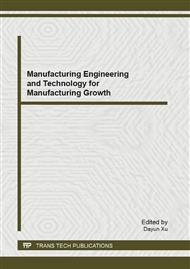p.343
p.350
p.359
p.367
p.372
p.380
p.386
p.390
p.396
Research on the Comprehensive Reliability Assessment Process for Products
Abstract:
For problems, such as evaluation model selection is not appropriate and accuracy of the assessed value is low, exist in the reliability assessment of mechanical and electrical product, we propose a comprehensive reliability assessment process for mechanical and electrical products. In this paper, we discuss methods of reliability data collection and collation first. Then, criteria of preliminary screening for failure data are established. Furthermore, considering that life cycle of product is characterized by varied environment and varied population, it gives the method and steps for reliability assessment of produces. In addition, the process is used in the reliability assessment of products, and the calculation result illustrates that the process can be successfully applied to engineering practice. The process proposed in this paper provides a technical means for model selection in reliability assessment of mechanical and electrical product, and serves as the theoretical guidance for reliability validation and reliability design of product.
Info:
Periodical:
Pages:
372-379
Citation:
Online since:
December 2012
Authors:
Price:
Сopyright:
© 2013 Trans Tech Publications Ltd. All Rights Reserved
Share:
Citation:


